#anti state
Text

158 notes
·
View notes
Text
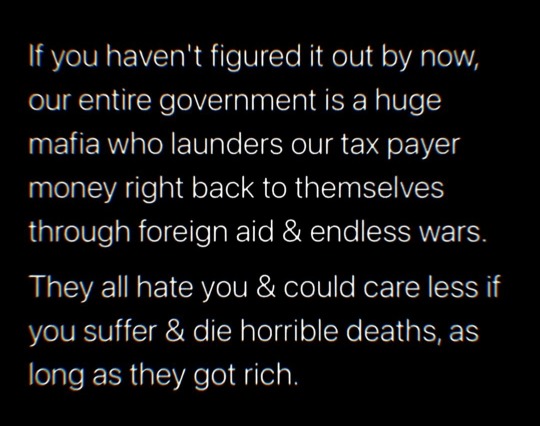
They just want you to not think and pay taxes.
54 notes
·
View notes
Text
Being an anarchist means:
You oppose Israeli occupation of Palestinian territories.
You oppose Russian imperialism in Eastern Europe
You oppose British colonialist presence in Ireland
You oppose Chinese oppression of Tibetans and Ugyghrs
You oppose American capitalistic exploitation of Africa and South America.
You oppose Iranian persecution of religious minorities.
You oppose ANY form of hierarchy, hegemony, or monopoly.
Being an anarchist means you either fight for the absolute freedom and equity of all humanity, or you just sit on your hands praying the "elites" show you their non-existent mercy.
#anarchy#anarchism#anti state#anti imperialism#anti fascism#anti communism#anti colonialism#anti zionisim#anti nazism#anti capitalism#anti corporations#indigenous rights#queer rights#human rights#freedom#fraternity#equality
44 notes
·
View notes
Text
Today we lost Ted Kaczynski. It's not surprising, we all knew that day was around the corner, considering his diagnosis, but hearing about it still shook me a bit. He was certainly not a flawless person, but his uncompromising devotion to defending the wild against the system of civilisation will forever earn him my respect. We need more people of such powerful character, determination and wit. Rest in power, Uncle Ted 💚
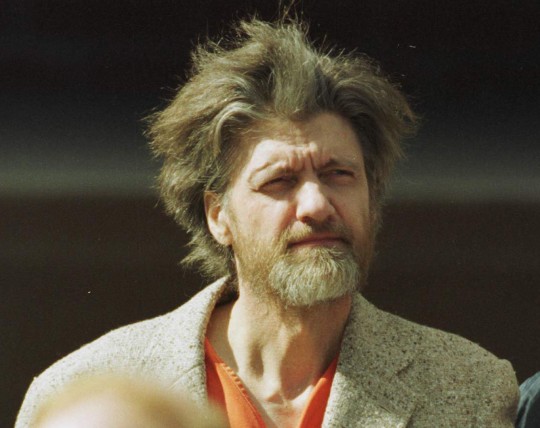
#anarcho primitivism#anti civ#green anarchy#anprim#anprimgang#luddism#deep ecology#luddite#ted kaczynski#unabomber#rest in power#anticiv#anti state#anti tech#anarchy#anarchism#green anarchism#eco anarchism#deep green#revolution#earth first!#earth liberation#earth love#ecocentrism#biocentrism
173 notes
·
View notes
Text
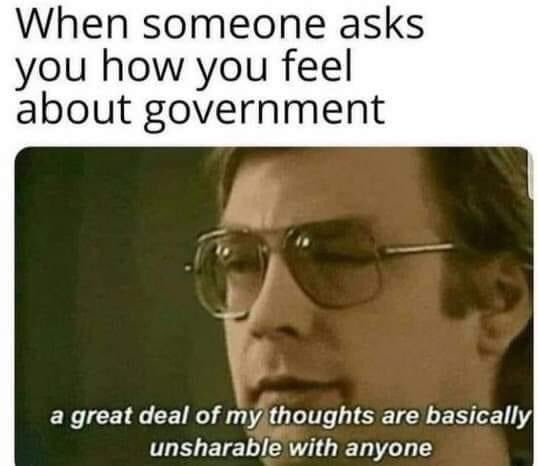
#meme#memes#shitposting#shitpost#humor#dark humor#funny memes#funny#funny humor#goverment#statism#anti state#anti authoritarian#irony#sarcasm#satire
160 notes
·
View notes
Text

32 notes
·
View notes
Text

469 notes
·
View notes
Photo

“These are the Guilty!”
313 notes
·
View notes
Text
No cops at pride
No military at pride
No arms dealers at pride
No banks at pride
#do you see where I'm going with this#pride month#pride parades#anti capitalist#anti military#anti state#pride is meant to be a fucking protest
475 notes
·
View notes
Text
the importance of social technology in social change
TLDR: By retooling, devouring, and innovating our social technologies, we can create participatory organizations that enable egalitarian social change. These organizations should be animated by an understanding of hierarchy, its relation to oppression writ-large, and how to create and employ social technologies that distribute power, rather than concentrating it.
Introduction
We take technology for granted in general (most people I know don’t think much about how water gets to their sink unless it doesn’t work, for example), but this seems especially true for our social technologies. We take things like democracy, laws, and even the nuclear family form at face value and as fundamental parts of reality.
So, what is technology, and how does it relate to our pending conversation? What is the throughline between obvious technologies like a stone axe and my iPhone, and more nebulous ones, like speech and the nuclear family? Any technology you can imagine takes concepts and knowledge and creates a method of applying them to specific goals, objectives, or functions. This doesn’t preclude emergent uses for tools, as you can probably think of using tools in unintended ways. This definition is useful to keep in mind as we realize that the technologies at present, animating the status quo are inadequate. We need something different to make radical, roots-grasping change.
And, for the sake of change, we need a specific way to achieve it. Part of this is technological; we need to figure out models of relating and working with one another that prefigure the changes that we want to see. To create and modify those technologies, we need to figure out which concepts and knowledge we will use.
Prefiguration can be described as “creating the new world in the shell of the old”. It’s doing things in the present that we think will get us to our imagined future. This implies the need to have a coherent conception of what is currently happening, and change will look like.
Currently, we live in a hierarchical, bureaucratic hell. This might best be epitomized by trying to obtain official identification recognized by our respective state. From all of the forms that you fill out, to the additional paperwork needed, to the horrible experience of getting that information approved, there are a lot of issues that this creates, from an experiential standpoint. One of the more under-realized aspects of issues such as this is how these experiences alienate us from the ability to do things for ourselves. Bureaucracy is a way to manage hierarchy’s inherent simplification of reality. A king couldn’t actually run their kingdom themselves, so they create layers of functionaries, under their control, to (try and) manage that complexity.
Along with my opposition, I’d like to propose something. A theory of change, that allows us to do that prefiguration work, leaving behind some of the negative methods of relating as currently mediated and handled. Since we live in a very hierarchical and bureaucratic world-system, constituting a colonial-imperialist, cisheteropatriarchical, ableist hegemony, if we create non-hierarchical/heterarchical organizational forms that allow us to relate in alignment with our values, then we will achieve a more egalitarian world, because of these organizational forms addressing fundamental contradictions in the way that society, from the personal to the global scale, is administered and ordered at present.
Having non-hierarchical organizational forms will allow us to become self-managed and autonomous, gaining collective control over collective issues, and individual control over individual issues. What is hierarchy, though? For our purposes, hierarchy can be seen as the glue that brings oppression together. It binds structures of domination, coercion, and power (specifically power-over) into oppression writ-large. This is what makes the act of arranging organizational forms a pyramid, where value, authority, and decision-making ability are concentrated toward the top. It is not a problem if some friendly games and competitions employ hierarchy in the broadest sense. The issue comes where, in that game, the folks who won got to eat and the folks who lost went hungry. The power imbalance and value judgments are what make hierarchy dangerous.
Alternatively, non-hierarchical structures that prioritize non-coercive, non-domineering principles, that enable positive versions of power-to (the ability to act) and power-with (the ability to act collectively, towards collective interest) have much more liberatory potential at their foundation. That’s what we’re aiming for, social technologies that allow for horizontal relating.
The pieces of horizontal organizations
The foundation of these horizontal, heterarchical forms should be in values and principles that enable relating in that way. Some of these values might be joy, autonomy, radically informed consent, cultivating ownness-uniqueness, and solidarity. These are defined as:
Joy: This should be a group that is constantly looking critically at how we engage with productivity, work, and formality from the perspective of prefiguring spaces of fun, play, and levity -- infusing it into as much of the work as we can. If it feels like a drag, that should at the very least give us pause. While we will not be able to avoid negativity wholesale, we can be intentional about minimizing the moments where it is unnecessary.
Autonomy: Each unit of interest (teammate, team, section/wing, whole) can operate independently from other elements as it desires, without imposition.
Radically Informed Consent: All decisions that include or impact someone should be made with that person (1) in that discussion/process and (2) having as much context and information as they need to be aware of the implications of the decision being made.
Cultivating Ownness-Uniqueness: The group should allow for a cooperative orientation that is based on finding what is best for all involved as individuals, concerning the collective goals. The group should be a tool that cultivates this orientation, rather than existing for its own sake and becoming something that holds power over the people in the space.
Solidarity: People in the group should work together around common interests and affinities, made clear in the joining process, grounded in (1) centering the most marginalized in society and/or our specific context within our spaces, and (2) sharing in the responsibilities of achieving what the group sets out to do.
Having these values as described gives us a shared language from which to judge how we relate to each other using the organizational forms we will set out to describe, to make sure that it gives opportunities to widen the spaces where our organizational aims can be achieved.
The components of these forms, the building blocks that sit atop the foundation, creating the organization when assembled, are the teammate, roles & tasks, aims & domains, the team, assemblies and summits, and the areas, functions, and committees. These are defined as:
Teammate: This is the individual in the structure. A specific person, who interfaces with the other parts of the structure.
Roles and Tasks: This is how the work is distributed within an organization, in line with the foundational principles and the aims of the specific team and organization as a whole.
aims: Objectives of the unit of interest. The thing that the unit of interest is trying to accomplish.
Domains: The range of focus a specific unit of interest has within an organization. What the unit of interest is responsible for doing.
Team: A collective unit within the structure. Multiple teammates coming together.
Assemblies and Summits: Multiple teams (or delegations of teams) coming together to deliberate on mutual aims, across mutual domains.
Areas, Functions, and Committees: Ways to group teams together (or create new teams) to cover specific aims.
These allow for us to have specific modes of relating with each other around specific things that we want to accomplish, from the individual to the organization-wide scale, with the potential to connect with outside organizations.
These values and components are important to create are heterarchical organization, but it doesn’t tell us what the organization will be doing. We know that it’s meant to be aimed towards social change, but what does that actually look like? I think that there are three interrelated things that the organization should achieve for it to be successful at its overall aims. There should be robust analysis, care work, and effective, radical action. These are described as:
Care Work: Embedding the ideas of restoration, rest, healthy engagement, sustainability, and healing into the core of the organizational structure. This can be done through things like healing circles, accountability circles, meeting "non-organizational" needs that deal with the making and remaking of folks (a la childcare, food, emotional care, etc), and other methods.
Robust analysis: Creating mental models that can approach an accurate understanding of the world, along with how to be experimental and learn from those experiments (while not seeing participants as disposable, or coercing folks into things). This horizontal orientation encourages us to be able to catalyze autonomous & self-directed action, rather than make ourselves indispensable to a movement. We should use these forms to organize ourselves out of a role, in a sense, through things such as making sure other people understand how to do what we do, and not hyper-specializing.
Effective, Radical Action: The organization, through the above two functions, should be able to achieve the goals that it sets. It should be successful at the current conjuncture, and these successes should build up to the general goals of the organization. There should be a conception of strategy, campaigns, logistics/operations, and tactics.
For any of these initiatives to be successful, there needs to be a basic security culture. Pretty much any social change org that is directly effective or building towards effectiveness necessitates modes of protection for the people in the organization. We need to protect from state, corporate, and non-state reactionaries. This is worth an in-depth conversation, but basic things like not talking to those forces, being mindful of where and when certain information is shared, if at all, and screening for new members, the intensity of which is proportional to the openness of the organization, and not fedjacketing (claim that someone is the cops) people. This would be paired with collective discussion to establish those agreements, and training/collective study to inoculate folks against bad security practices.
Arranging the pieces
Now that we’ve built up the different parts of our organizations, we can describe some ways to bring them together. I propose three different organizational shapes: phantom cells, networked guerrillas, and fractal teams and working groups. These are differentiated by the ways that the teams within the org are connected and relate to one another.
Phantom cells are the most ephemeral formation that I’ll describe. These are temporary teams created with wide variations towards some goal. They don’t even have any meaningful awareness of the composition of other cells. Actions are motivated by catalyzing forces that follow a general flow of event → action → report-back → action. Something happens that motivates a cell to form and act, that cell publishes information about their action, along with instructions on how to replicate and the ideological motivation behind it, and others follow suit. This repeats and spreads out, through stigmergy. It’s like how social media trends work. All follow a similar format, evolving as they spread until they saturate a space and wane. The goal here is to combine distributed intelligence through information posting, replicability, and inspiration.

A diagram representing phantom cells. Pill shapes with the word team in the middle are spread around on a white canvas.
This form is inspired by Tiktok and the SHAC campaign. If we could have groups of folks who: (1) find concrete goals & replicable methods for finding connected goals in specific contexts, (2) create compelling narratives around acting in line with those goals, and (3) encourage easily replicable actions, consistent pressure, and sharing the results so that it spreads. This allows for action to become highly distributed, where unity isn’t based on allegiance to specific organizations, movements, or formations. This type of operation is most useful for trying to achieve protracted, quick, decisive, small actions against a target.
Networked guerrillas are cells (or teams) of folks that have a well-rounded skill set, and who work consistently together. I imagine it being like a team for an RPG (role-playing game) campaign where each character is in a different class. This group should have a relatively high amount of self-sufficiency, to be able to achieve aims within their domain without much outside assistance. Each cell is animated by a general alignment of principles, vision, and values. Cells are also designed to link up with other cells, of this type, to accomplish bigger goals and complete bigger actions. There might also be a bundle of cells “in the middle” to help coordinate resources between cells and provide additional, more specialized, and contextual resources. Ideally, there is a rotation and continual morphing of the core to not become a failure point. This is why it’s important to have the cells be as self-sufficient as possible. Every connection is an enhancement of capability, rather than a necessity. The relationships between the cells can be organized like a mesh network (many-to-many relationships between the cells), star (one-to-many-to-one relationships), and a chain/ring (one-to-one-to-one relationships), or some combination, based on the needs of the organization.

A diagram representing networked guerrillas. showing a form that combines mesh, start, and chain/ring.
Fractal teams and working groups work through a kind of fractal, heterarchical confederalism. Essentially, it flips the hierarchical nature of authoritarian federalism by having power flow from the lowest level upwards, rather than the other way around. It starts at the lowest level, the team, and we confederate upwards from there to encompass more general aims and domains, using assemblies, assemblies of assemblies, and summits. This structure also operates on the principle of autonomous collaboration, where people who are impacted by and/or are doing a specific set of tasks are the ones to decide how that task is implemented. This is meant to minimize the amount of power-over within the structure, while still fostering modes of engagement between different scales of decision making. At each level, there would be assemblies that provide the space to share information and discuss plans, and for potential working groups to meet and freely associate and dissociate as necessary. Decisions shouldn’t be made here at these higher levels of the hierarchy, as that leads to a form of power that isn’t always deliberative. Folks would execute whatever plans they see fit on the ground, based on self-organization, informed by the information that is shared within these more open, popular gatherings. The trust is put on folks to be self-directed around their needs, getting help and providing assistance in a mutualistic way, rather than a top-down way.
a diagram of the fractal teams & working groups. teams send delegates to assemblies, and assemblies send delegates to assemblies of assemblies or summits. delegates gather information and context at the above levels and come back to their team to provide context and give information to the team. They also will share the decisions made by the teams, to the assemblies and summits.
All of these forms would need some kind of intelligence apparatus. Intelligence for us will be information that allows us to achieve objectives better. We gain this information through research, investigative journalism-style methods, and espionage. It is pertinent, practical, and informative. These apparatuses will gather information (what we might usually think of as intelligence), and prevent/impede opposition from doing the same (counterintelligence). This is not something it seems like social change folks are intentional about very often, but is an important part of building, refining, and achieving the aims laid out at every scale, from strategies for wider social change to specific actions.
The basic structure of this intelligence apparatus is a specific unit of interest would (s)elect/delegate an intelligence handler to work within that unit’s domain. This handler is one part of an intelligence cell. The cell would be a compartmentalized team for the sake of mutual protection, containing a handler, analyst(s), and agent(s). Handlers are the cell coordinators, recruiting the other roles as they see fit. They act as the direct link/contact to the agent on the ground/in the field, supporting them on their missions with whatever they need. Handlers also support analysts with collaborating on research work or anything that they need. Handlers are the glue of a cell, supporting everyone towards their objectives. Analysts are the folks who make the information gathered by the agents usable. They sort and organize the information, making things like reports and presentations so that action can come from or be informed by the information. Handlers may support the analysts with those tasks. Agents are the crux of this cell—they gather the intelligence. They should be a generalizing specialist, where they understand the breadth of the context in which they act, even with a specific specialty in the type of intelligence they gather.
For these purposes, there will probably be a combination of focus on open-source intelligence, signals intelligence, and human intelligence. Finally, we have the auditor. They are also elected by the unit of interest (the one that placed the handler). This is a way to make sure there isn’t any tomfoolery happening within the cell—the auditor can look over any of the information within the cell, and compile an independent report for the sake of the unit of interest.
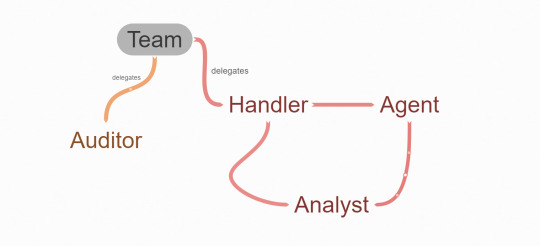
A diagram of the basic intelligence apparatus.
The basic intelligence process would go as follows: Information would be split or categorized into four main areas: strategic, campaign, logistic/operational, and tactical. For each of these levels, there would be a repeating loop process of setting goals in relation to those areas, gathering the information, analyzing it, figuring out how to use it, and a method to evaluate the process. Information can be gathered by agents or anyone else in the organization, anonymously. This helps bolster the capacity of information gathering.
So, we start by asking, what do we need to know to achieve our aims? Then, we ask about where we can find that information. As we’ll probably receive more information than what is usable, we want to ask about what information found is important, timely, and accurate/verifiable? After that, we want to ask how we can package and disseminate the information, along with an understanding of the audience(s). That leads us to review what we’ve done, integrate any changes, and start the process over. This is not to say that teams can’t do intelligence-gathering work themselves, such as scouting or information synthesis. It is just useful to have capacity specifically built for that work.
How these forms relate
Finally, we want to look at the relationship between the organizational forms, and how these forms change, depending on what the specific organization does. We can do this by understanding how things look through the classifications of overt, covert, and clandestine.
Overt organizations act out in the open. They operate in a mode where what you see is what you get. Phantom cells might operate as front-facing aboveground collectives of folks who have a very specific focus, with the intent to popularize and virally spread action around that focus, through building (para)social relationships. Networked guerrillas might make more intentional, long-term connections between cells, leading to a more tightly bound network. This could look like the mesh model. Fractal teams might have highly accessible and legible teams and assemblies with centralized information pipelines, creating an easy way to get involved with the movement. This point is important when we’re thinking about how to make the movement accessible.
Covert organizations act in secret, operating on the mode of plausible deniability. Phantom cells might use mainstream channels to share their ideas but operate in a way that obscures their identities. Networked guerrillas might have the cells be related using a star model, with many connections compartmentalized by those shared nodes. Fractal teams might hide membership and focus on the intake process because this formation is the most vulnerable to infiltration. Maybe this formation isn’t useful outside of the overt context.
Clandestine organizations are fully underground. Phantom cells might only spread action through hyper-encrypted or low-tech methods. Networked guerrillas might have no awareness of who or what the composition is of other teams in the network, and any connections between cells might be mediated in ways that maintain anonymity and prevent infiltration. Fractal teams likely would be a great weakness in this context.
Looking at all of these forms, across different modes of operating, we should not “pick” one form or the other in a dogmatic way. Each form should see the others as providing something of value towards anti-authoritarian ends. In other words, fractals should not decry networks or phantoms for their seemingly chaotic structures or methods. Phantoms shouldn’t shit on the other two for not being effective enough. Aligning people and actions across these horizontal forms will allow an ecosystem of forms that reinforces the ability of each to succeed. Overt groups can act as an auxiliary force for the covert and clandestine groups, and the covert and clandestine groups can create spaces for the overt groups to construct the world they are all working for.
By having principles and ethics that are sound, exploring what organizations need to do, and creating structures that enable those ethics and principles to be realized, we can have social technologies that allow us to more easily accomplish the social change that we’re seeking.
#direct action#solarpunk#social revolution#social relations#socialism#anarchism#anarch#anarchocommunism#anarchist#organizing strategy#organizing#insurrection#council communism#councilism#libertarian socialism#anarchy#leftist#leftism#anti state#antistate#anticapitalism#anti capitalism#organization#organização#organización
15 notes
·
View notes
Text

#lgbtq#lgbt rights#trans lives matter#trans rights#liberty movement#libertarianism#libertarian#freedom#anarchy#anarchist#freeblr#ancap#anti state
119 notes
·
View notes
Note
What are your thoughts on how many anarcho-primitivist/luddite/anticiv spaces have been taken over by right-wing types? It seems less people are actually engaging in primitivist thought and more so thinking it's "based" and "trad."
I saw how you got downvoted for insulting whatalthist, and this is what led me to ask this question.
I'm assuming you're referring to online spaces. There's a strong effort by the right to co-opt primitivism. There are some forums that are frequented by right-wingers, though they're in the minority; most problematic spaces are the ones about Kaczynski and things directly related to him. There are also many social media accounts that express primitivistic ideas in combination with authoritarian and rightist politics (e.g. individuals who adore both Ted Kaczynski and Pentti Linkola). Most concerning to me are actually the offline examples that get press coverage.
I see this as being both due to deliberate efforts to co-opt primitivism, much in the manner Nazis co-opted socialism, and due to ignorance on the part of many right-wingers. It isn't too hard to misinterpret Kaczynski's remarks about leftism if you read him inattentively, and conclude that he must be some sort of right-winger. Ted's mistake was focusing on attacking the left too much and worrying too little about the right, but at the time he wrote his manifesto this choice made sense.
Ted was a fan of Earth First! and when he wrote Industrial Society and its Future the wounds of an ideological split within it were still fresh. EF! started out as a truly ecocentric movement with extremely narrow goals of protecting the wilderness from the ravages of industrialism and other harm caused by civilized humans. After gaining a lot of momentum, EF! attracted thousands of newcomers, many of whom leaned more to the side of leftist humanism than deep ecology, causing conflict — the newcomers were trying to transform the movement into one about ecology-related social justice issues, while the original Earth First!ers preferred to only focus on wilderness conservation. (For more on this check out Earth First!: Environmental Apocalypse by Martha F. Lee). The right-wing in America at the time was comprised mostly of people who were staunch prometheans, warmongers, etc., and Ted rightly assumed they weren't going to take over his movement. However as the political climate changed they became one.
The US and the rest of the "West" seems to be experiencing a rise in right-wing back-to-nature ideas, similar in many ways to the so-called "right-wing hippies" of the Weimar republic. I'm talking about doomsday preppers, christian nationalist communes, etc. Kaczynski did not anticipate this, and by the time news about who was adopting (some of) his ideas — not just anarchists and former Earth First!ers, but people including the Greek fascist Golden Dawn party, and Andreas Breivik — reached Kaczynski in his supermax prison it was a bit late. He penned a short note titled Ecofascism: An Aberrant Branch of Leftism in 2020, arguing against their ideas and saying he's their enemy. However, more people read and will read ISAIF in the future than this obscure note and the few other scattered critiques of the right that can be found throughout his work.
What we need to do is to aggressively shun these types until we successfully repel them. This applies to real life and online interactions. There will always be some who'll try to co-opt primitivism, but this big wave needs to be halted. There are also some who are genuinely willing to learn and adjust their beliefs, but they're few in between. It's necessary to distinguish between the two, keep the latter and reject the former.
#anarcho primitivism#anti civ#anarchy#green anarchy#anprim#anticiv#anprimgang#luddism#deep ecology#luddite#theodore kaczynski#ted kaczynski#anti state#modernity#unabomber#environment and nature#environment#earth liberation#earth first!#earth love#primal anarchy#anarcho primitivist#primitivism#ecocentrism#eco anarchism#anti tech
51 notes
·
View notes
Text
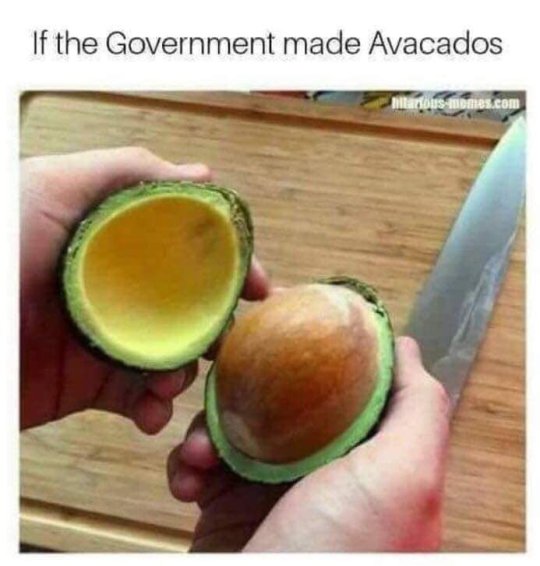
#meme#memes#shitposting#shitpost#humor#silliness#funny humor#funny#funny memes#goverment#statism#anti state#anti authoritarian#lol#sarcasm#satire#irony
64 notes
·
View notes
Text
My new ocs

He's albino, xhosa, his names Mbulelo, 19

Hes Ghanaian African-American, Xavier, 19
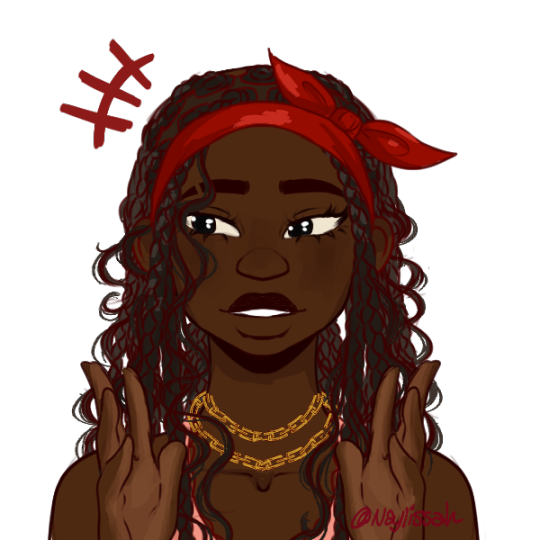
She's Egyptian-Somalian, Tamara, 17

Nikalis, he's African-European, 15

She's kenyan, her names Chuki or Jamilah, 22
----------------------------
Lore time:3
| Main characters |
~Xavier~

He grew up in a rough area with alot of gang violence and stuff, and his mother weren't exactly wealthy but tried her best to get Xavier into the best education possible with her budget
His father when Xavier was a couple months old, but Xaviers rather glad because his mothers friends have mentioned he was abusive to his mother and an alchoholic
Xavier lives on his own and Nik usually sleeps over bc they're rlly close(ill get into this later) and he's dating Tamara
He's deeply closeted, and is actually bi
“Poverty isn’t a lack of character. It’s a lack of cash.” — Rugter Breghmen
----------------------------
~Nikalis~

Nikalis grew up in the suburbs, in a very privleged, sheltered, and borderline racist house hold
as a young child, he feared poc people due to his parents influence, he was bullied alot by older kids, he hated going to preschool.
But one day an older poc kid saves him from the bullies, which changed his entire world view, when he asked the older child's name, he responded with Xavier.
They've been close ever since, with Nikalis rebelling against his parents and hanging out more with Xavier than hus own family.
Nik is deeply closeted aswell, he's gay and has a crush on Xavier
“Sometimes I feel like rap music is almost the key to stopping racism.” — Eminem
----------------------------
~Tamara~

Tamara is a strong and independent 17-year-old woman. She is from the same neighborhood as Xavier
She is smart and ambitious, and she has big dreams for her future. Tamara is also a feminist, believing in ALL woman's rights
She is a role model for her younger sisters and brother, and she is determined to make a difference in the world. Her father died of lung cancer when she was 12
She's moved past it now but it still Hurts sometimes
She's dating xavier and is friends with Nik
“Words have power. TV has power. My pen has power.” — Shonda Rhimes
----------------------------
~Mbulelo~

Mbulelo was born an albino in a Xhosa community where such a condition was seen as a curse. His parents were ashamed of him and treated him like an outcast.
Despite their cruelty, Mbulelo remained respectful to them, knowing that they were his family. However, he found solace and love in his grandparents, who embraced him for who he was.
As he grew older, Mbulelo became increasingly blunt and outspoken, using his voice to challenge the stigma surrounding albinism.
Mbulelo lives with hus grandparents and is friends with Xavier, he feels neutral, borderline contempt towards Nikalis, and has a crush on Tamara
“Freedom is the inherent state of nature. A bird is free until you clip its wings and put it in a cage. Just because you pick up its shit, give it food and water, and let it do as it pleases within the confines of its cage does not make it any less a captive. Even if the cage was made of pure gold, the ornate bars would serve the same purpose.” — Dane Whalen
----------------------------
~Chuki~

Chuki is a Kenyan woman who stands out with her love of all things pink and her bubbly personality.
Despite her challenges with ADHD, dyscalculia, and dyslexia, she's a fighter who has overcome obstacles to secure a scholarship to the school the others go to
Hailing from a loving family in Kenya, Chuki cherishes her time at school, But still misses her parents and family
Having recently received her diagnosis, she's determined to thrive academically and embrace her unique strengths. With her infectious smile and unwavering spirit, Chuki is an inspiration to all who know her.
“Life is too important to be taken seriously.” — Oscar Wilde
FIN.
#oc art#oc#my oc stuff#oc lore#lore#original character#picrew#the sillies#theyre so little#concept art#character concept#oc concept#albino oc#poc ocs#poc characters#lgbtq#anti state
4 notes
·
View notes
Text
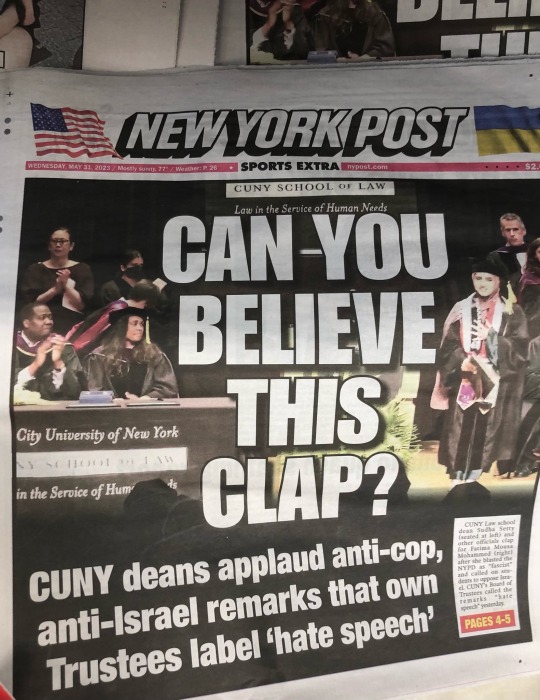
[ID: Photograph of the front page of a ‘New York Post’ newspaper. Titled in large bold white letters it says: CAN YOU BELIEVE THIS CLAP?
The caption beneath it reads: “CUNY (City University of New York) deans applaud anti-cop, anti-Israel remarks that own Trustees label ‘hate speech’”. /End ID]
Spotted in a grocery. Lmao. Threatening me with a good fucking time.
#anti israel#palestine#cuny#cuny school of law#new york#new york post#anti cop#acab#anarchism#anti state#antiauthoritarian#free palestine#all cops are bad#all cops are bastards#fuck the police#jrnl#like what an amazing way to make them sound badass & cool
5 notes
·
View notes
Photo

“Destroy Capitalism, Destroy the State.
Anarchist Communism Now!”
libcom.org / crimethinc.com
123 notes
·
View notes